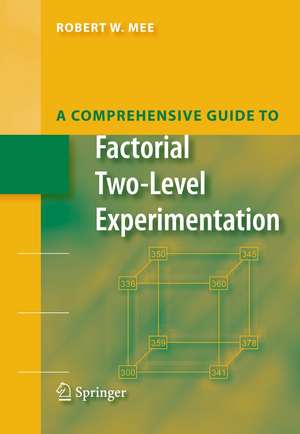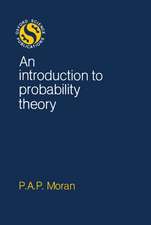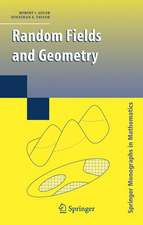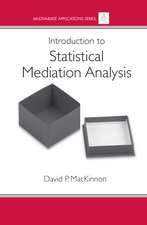A Comprehensive Guide to Factorial Two-Level Experimentation
Autor Robert Meeen Limba Engleză Paperback – 5 sep 2014
Focusing on factorial experimentation with two-level factors makes this book unique, allowing the only comprehensive coverage of two-level design construction and analysis. Furthermore, since two-level factorial experiments are easily analyzed using multiple regression models, this focus on two-level designs makes the material understandable to a wide audience. This book is accessible to non-statisticians having a grasp of least squares estimation for multiple regression and exposure to analysis of variance.
"This book contains a wealth of information, including recent results on the design of two-level factorials and various aspects of analysis… The examples are particularly clear and insightful." (William Notz, Ohio State University)
"One of the strongest points of this book for an audience of practitioners is the excellent collection of published experiments, some of which didn’t ‘come out’ as expected… A statistically literate non-statistician who deals with experimental design will have plenty of motivation to read this book, and the payback for the effort will be substantial." (Max Morris, Iowa State University)
| Toate formatele și edițiile | Preț | Express |
|---|---|---|
| Paperback (1) | 710.09 lei 6-8 săpt. | |
| Springer – 5 sep 2014 | 710.09 lei 6-8 săpt. | |
| Hardback (1) | 660.18 lei 6-8 săpt. | |
| Springer – iul 2009 | 660.18 lei 6-8 săpt. |
Preț: 710.09 lei
Preț vechi: 835.40 lei
-15% Nou
Puncte Express: 1065
Preț estimativ în valută:
135.89€ • 140.38$ • 113.10£
135.89€ • 140.38$ • 113.10£
Carte tipărită la comandă
Livrare economică 26 martie-09 aprilie
Preluare comenzi: 021 569.72.76
Specificații
ISBN-13: 9781489982704
ISBN-10: 1489982701
Pagini: 568
Ilustrații: XXIII, 545 p.
Dimensiuni: 155 x 235 x 30 mm
Greutate: 0.79 kg
Ediția:2009
Editura: Springer
Colecția Springer
Locul publicării:New York, NY, United States
ISBN-10: 1489982701
Pagini: 568
Ilustrații: XXIII, 545 p.
Dimensiuni: 155 x 235 x 30 mm
Greutate: 0.79 kg
Ediția:2009
Editura: Springer
Colecția Springer
Locul publicării:New York, NY, United States
Public țintă
Professional/practitionerCuprins
Full Factorial Designs.- to Full Factorial Designs with Two-Level Factors.- Analysis of Full Factorial Experiments.- Common Randomization Restrictions.- More Full Factorial Design Examples.- Fractional Factorial Designs.- Fractional Factorial Designs: The Basics.- Fractional Factorial Designs for Estimating Main Effects.- Designs for Estimating Main Effects and Some Two-Factor Interactions.- Resolution V Fractional Factorial Designs.- Augmenting Fractional Factorial Designs.- Fractional Factorial Designs with Randomization Restrictions.- More Fractional Factorial Design Examples.- Additional Topics.- Response Surface Methods and Second-Order Designs.- Special Topics Regarding the Design.- Special Topics Regarding the Analysis.- Appendices and Tables.- Upper Percentiles of t Distributions, t.- Upper Percentiles of F Distributions, F.- Upper Percentiles for Lenth t Statistics, and.- Computing Upper Percentiles for Maximum Studentized Residual.- Orthogonal Blocking for Full 2 Factorial Designs.- Column Labels of Generators for Regular Fractional Factorial Designs.- Tables of Minimum Aberration Regular Fractional Factorial Designs.- Minimum Aberration Blocking Schemes for Fractional Factorial Designs.- Alias Matrix Derivation.- Distinguishing Among Fractional Factorial Designs.
Recenzii
From the reviews:
“Robert Mee’s new work on two-level factorial designs is an unusually good statistics book, which should be bought and read by anyone with even a passing interest in the subject. This book covers almost everything users of two-level factorial designs need to know. Experimenters, statistical consultants, and researchers will all learn a lot and find plenty of new ideas to think about. …Careful thought has been given to how to describe every single topic. The result is a book that deserves to become a classic.” (Biometrics)
“Mee’s new book is … a comprehensive guide to factorial two-level experimentation. … I believe this book will help nonstatisticians and statisticians … plan and analyze factorial experiments correctly. The breadth, depth, and clarity of this book make it a valuable asset for anyone using two-level of factorial designs. The large number of examples … adds much to the book’s utility. … Overall, this is an excellent reference book … . it should be in the library of anyone who uses two-level factorial designs.” (Lewis VanBrackle, Technometrics, Vol. 52 (4), November, 2010)
“Robert Mee’s new work on two-level factorial designs is an unusually good statistics book, which should be bought and read by anyone with even a passing interest in the subject. This book covers almost everything users of two-level factorial designs need to know. Experimenters, statistical consultants, and researchers will all learn a lot and find plenty of new ideas to think about. …Careful thought has been given to how to describe every single topic. The result is a book that deserves to become a classic.” (Biometrics)
“Mee’s new book is … a comprehensive guide to factorial two-level experimentation. … I believe this book will help nonstatisticians and statisticians … plan and analyze factorial experiments correctly. The breadth, depth, and clarity of this book make it a valuable asset for anyone using two-level of factorial designs. The large number of examples … adds much to the book’s utility. … Overall, this is an excellent reference book … . it should be in the library of anyone who uses two-level factorial designs.” (Lewis VanBrackle, Technometrics, Vol. 52 (4), November, 2010)
Textul de pe ultima copertă
Factorial designs enable researchers to experiment with many factors. The 50 published examples re-analyzed in this guide attest to the prolific use of two-level factorial designs. As a testimony to this universal applicability, the examples come from diverse fields:
Robert W. Mee is Professor of Statistics at the University of Tennessee. Dr. Mee is a Fellow of the American Statistical Association. He has served on the Journal of Quality Technology (JQT) Editorial Review Board and as Associate Editor for Technometrics. He received the 2004 Lloyd Nelson award, which recognizes the year’s best article for practitioners in JQT.
"This book contains a wealth of information, including recent results on the design of two-level factorials and various aspects of analysis… The examples are particularly clearand insightful." (William Notz, Ohio State University
"One of the strongest points of this book for an audience of practitioners is the excellent collection of published experiments, some of which didn’t ‘come out’ as expected… A statistically literate non-statistician who deals with experimental design will have plenty of motivation to read this book, and the payback for the effort will be substantial." (Max Morris, Iowa State University)
- Analytical Chemistry
- Animal Science
- Automotive Manufacturing
- Ceramics and Coatings
- Chromatography
- Electroplating
- Food Technology
- Injection Molding
- Marketing
- Microarray Processing
- Modeling and Neural Networks
- Organic Chemistry
- Product Testing
- Quality Improvement
- Semiconductor Manufacturing
- Transportation
Robert W. Mee is Professor of Statistics at the University of Tennessee. Dr. Mee is a Fellow of the American Statistical Association. He has served on the Journal of Quality Technology (JQT) Editorial Review Board and as Associate Editor for Technometrics. He received the 2004 Lloyd Nelson award, which recognizes the year’s best article for practitioners in JQT.
"This book contains a wealth of information, including recent results on the design of two-level factorials and various aspects of analysis… The examples are particularly clearand insightful." (William Notz, Ohio State University
"One of the strongest points of this book for an audience of practitioners is the excellent collection of published experiments, some of which didn’t ‘come out’ as expected… A statistically literate non-statistician who deals with experimental design will have plenty of motivation to read this book, and the payback for the effort will be substantial." (Max Morris, Iowa State University)
Caracteristici
Statistical design of experiments is useful in virtually every quantitative field Use of the simplest experimental designs is pervasive Practitioners interested in expanding their repertoire of tools will find this book a helpful guide The examples from many fields will give the book broad appeal Includes supplementary material: sn.pub/extras












